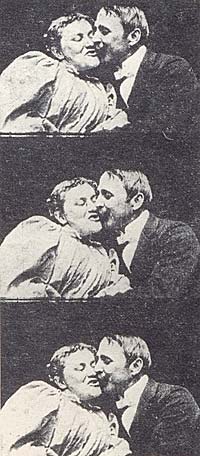The Kiss (1896 film)
From The Art and Popular Culture Encyclopedia
| Revision as of 18:07, 21 July 2014 Jahsonic (Talk | contribs) ← Previous diff |
Revision as of 19:15, 21 July 2014 Jahsonic (Talk | contribs) Next diff → |
||
| Line 1: | Line 1: | ||
| + | {| class="toccolours" style="float: left; margin-left: 1em; margin-right: 2em; font-size: 85%; background:#c6dbf7; color:black; width:30em; max-width: 40%;" cellspacing="5" | ||
| + | | style="text-align: left;" | | ||
| + | Now I want to smash The [[Vitascope]]. The name of the thing is in itself a horror, but that may pass. Its manifestations are worse. The Vitascope be it known, is a sort of magic lantern which reproduces movement. Whole scenes are enacted on its screen. [[Loie Fuller|La Loie]] dances, elevated trains come and go, and the thing is mechanically ingenious, and a pretty toy for that great child, the public. | ||
| + | |||
| + | Its managers were not satisfied with this, however, and they bravely set out to eclipse in [[vulgarity]] all previous theatrical attempts. | ||
| + | |||
| + | In a recent play called ''[[The Widow Jones]]'' you may remember a famous [[kiss]] which Miss May Irwin bestowed on a certain John C. Rice, and vice versa. Neither participant is physically attractive, and the spectacle of their prolonged pasturing on each other's lips was hard to bear. When only life-size it was pronouncedly beastly. But that was nothing to the present sight. Magnified to Gargantuan proportions and repeated three times over it is absolutely [[disgusting]]. All delicacy or remnant of charm seems gone from Miss Irwin, and the performance comes very near being indecent in its emphasized vulgarity. | ||
| + | |||
| + | Such things call for police interference. Our cities from time to time have spasms of morality, when they arrest people for displaying lithographs of ballet-girls ; yet they permit night after night a performance which is infinitely more degrading. The immorality of living pictures and bronze statues is nothing to this. The Irwin kiss is no more than a lyric of the [[Stock Yards]]. While we tolerate such things, what avails all the talk of American [[Puritanism]] and of the filthiness of imported English and French stage shows? --[[The Chap-Book]], June 15, 1896 | ||
| + | |} | ||
| + | {{GFDL}} | ||
| + | |||
| [[Image:Three consecutive frames of The Kiss (1896) - William Heise.jpg|thumb|right|200px|''[[The Kiss (1896 film) |The Kiss]]'' (1896) by William Heise]] | [[Image:Three consecutive frames of The Kiss (1896) - William Heise.jpg|thumb|right|200px|''[[The Kiss (1896 film) |The Kiss]]'' (1896) by William Heise]] | ||
| {{Template}} | {{Template}} | ||
Revision as of 19:15, 21 July 2014
|
Now I want to smash The Vitascope. The name of the thing is in itself a horror, but that may pass. Its manifestations are worse. The Vitascope be it known, is a sort of magic lantern which reproduces movement. Whole scenes are enacted on its screen. La Loie dances, elevated trains come and go, and the thing is mechanically ingenious, and a pretty toy for that great child, the public. Its managers were not satisfied with this, however, and they bravely set out to eclipse in vulgarity all previous theatrical attempts. In a recent play called The Widow Jones you may remember a famous kiss which Miss May Irwin bestowed on a certain John C. Rice, and vice versa. Neither participant is physically attractive, and the spectacle of their prolonged pasturing on each other's lips was hard to bear. When only life-size it was pronouncedly beastly. But that was nothing to the present sight. Magnified to Gargantuan proportions and repeated three times over it is absolutely disgusting. All delicacy or remnant of charm seems gone from Miss Irwin, and the performance comes very near being indecent in its emphasized vulgarity. Such things call for police interference. Our cities from time to time have spasms of morality, when they arrest people for displaying lithographs of ballet-girls ; yet they permit night after night a performance which is infinitely more degrading. The immorality of living pictures and bronze statues is nothing to this. The Irwin kiss is no more than a lyric of the Stock Yards. While we tolerate such things, what avails all the talk of American Puritanism and of the filthiness of imported English and French stage shows? --The Chap-Book, June 15, 1896 |
|
Related e |
|
Featured: |
The Kiss (also known as The May Irwin Kiss, The Rice-Irwin Kiss and The Widow Jones) is an 1896 actuality, and was one of the first movies ever shown commercially to the public. The film is around 47 seconds long, and depicts a re-enactment of the kiss between May Irwin and John Rice from the final scene of the stage musical, The Widow Jones. The film caused a scandalized uproar and occasioned disapproving newspaper editorials and calls for police action in many places where it was shown.
The film was directed by William Heise for Thomas Edison. In 1999 the short was deemed "culturally significant" by the United States Library of Congress and selected for preservation in the National Film Registry.
Public Exposure
The Kiss was projected in West End Park, Ottawa, Canada, on July 21 1896, and was long thought to be the first movie publicly shown in Canada. However, the competing Lumière Brothers Cinematograph had already exhibited different films in Montreal on June 27 1896 (Gaudreault & Lacasse 1996).
References
- André Gaudreault and Germain Lacasse (1996). "The Introduction of the Lumière Cinematograph in Canada," Canadian Journal of Film Studies, Volume 5, No. 2.


